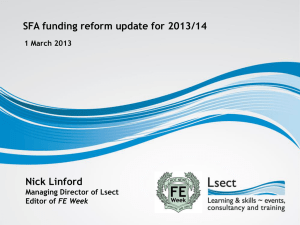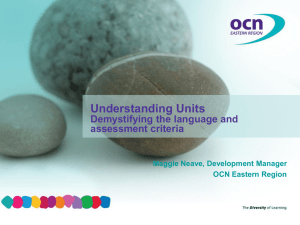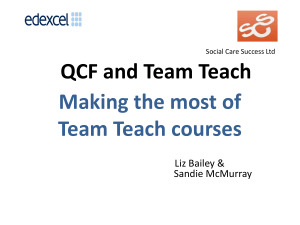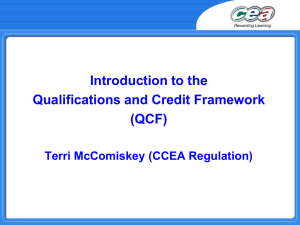QCF funding
advertisement
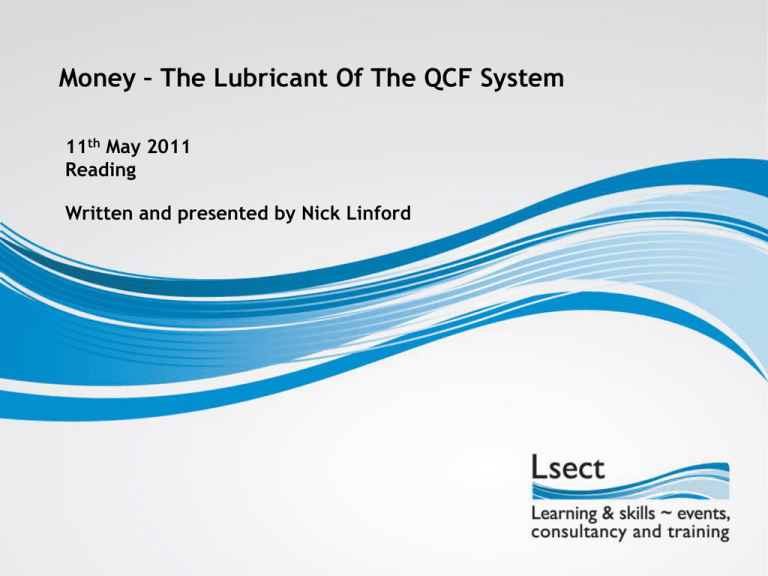
Money – The Lubricant Of The QCF System 11th May 2011 Reading Written and presented by Nick Linford Summary of the Framework QCF qualification, such as an Award 8 7 6 Level 5 Unit Unit Credit Credit Credit Credit 4 3 Full Level 3 = Diploma Full Level 2 = Cert and Diploma 2 1 Currently, not always and only post-19 Foundation Learning Curriculum E Award Cert 1-12 13-36 Diploma 37+ Credits bands (ish) Each credit represents 10 hours of learning time (not same as guided learning hours) Demand Led Funding formula QCF qualifications are funded using the DLF funding formula, which is an enrolment based funding methodology Therefore, every enrolment has an individual value Elements in the demand-led funding formula: > Standard Learner Number (SLN) > National Funding Rate (NFR) > Programme Weighting Factor (PWF) > Disadvantage Uplift (DU)* > Short Programme Modifier (SCM)** > Area Cost Uplift (ACU) Formula elements multiplied together equals maximum funding for the enrolment > Success Factor (SF)** * Not included for Train to Gain ** Not included for ER (Apprenticeships or Train to Gain) Learning Aim Database http://providers.lsc.gov.uk/LAD/ 50090768 SLNs and PWFs on the LAD SLN GLH / 450 = SLN Programme Weighting Factors A 1 B 1.12 C 1.3 D 1.6 E 1.72 F 1.4 G 1.92 H 1.2 J 1.25 K 1.5 L 1.15 Minimum attendance This is commonly referred to as the ‘definition of a start’ If an LR or ER withdrawal is before the minimum attendance period no funding is generated and the enrolment is not counted as a start Planned duration (calendar days) Minimum attendance 24 weeks or more 6 weeks 2 to 24 weeks 2 weeks Less than 2 weeks Once Co-funding for 19+ 50% of the unweighted funding (LR) or weighted funding (ER) Claiming demand-led funding Providers submit Individualised Learner Record (ILR) data online for funding and performance purposes Monthly for ER (01-13) and less frequently for LR (01-05) ILR ER or LR e.g. LR01 Monthly is on 4th working day OLDC portal & SAMS Data collection and payment systems Other related software and databases: > Learner Information Suite (LIS) > Learning Aims Database (LAD) > Data Self-assessment Toolkit (DSAT) Provider paid BACS payment on 10th working day Register of Regulated Qualifications http://register.ofqual.gov.uk/ Formally the National Database of Accredited Quals (NDAQ) Beware that when searching by learning aims you may need the forward slashes, e.g. 500/9076/8 This website includes individual QCF unit details, as well in mandatory and options information like: “To achieve this qualification all mandatory generic units must be achieved, all mandatory technical units must be achieved and a minimum of 12 credits from the optional group. A total of 54 credits are required to achieve this qualification.” Being on the Register does not mean it is fundable 16-18 qualification fundability The 16-18 qual advisory committee (JACQA) has been ‘dissolved’: “Further to the announcement in the YPLA e-bulletin Issue 11 (10-1110) the Department for Education has now approved around 1500 qualifications under Section 96; these have been added to the Section 96 website. ” http://www.education.gov.uk/section96/ “New accredited vocational qualifications for use post 16 will in general be approved.” For a spreadsheet of recently approved or amended Section 96 qualifications visit http://jacqa.ypla.gov.uk/ Following Wolf Review of 14-19 Vocational Education this likely to change. Rumour is the DfE will publish their response on Friday. 19+ qualification fundability The SFA QCF funding spreadsheets* QCF qualifications confirmed spreadsheet, last updated 20/04/11 ALR confirmed = 3,554 TtG confirmed = 1,739 Example information for a confirmed qualification: ALR conditional = 162 TtG conditional = 61 Example information for a conditional qualification: * Apprenticeships dealt with separately as part of mandatory Frameworks Funding rates QCF funding rates are in the main based on recommended GLH or where available, historical information and can change year on year Rates are recorded on the LAD, and can differ between age and funding stream. They can also be very different from the NQF qualification they replace QCF Diploma in Playwork (50090471) As you can see the funding rates (SLN and SLN GLH) differ, as do the programme weightings If a qualification is not on the LAD, funding cannot be claimed (regardless of what anyone or a spreadsheet tells you! Fundability and rate implications ~ Most vocational NQF quals no longer fundable (or soon to be ‘switched-off’) ~ Some quals will be fundable, but maybe for only some learners ~ Some quals will be fundable, but maybe for only some funding streams ~ Rates can change year on year ~ The QCF funding rates can be very different from previous quals So ~ Providers should keep checking the spreadsheet and the LAD ~ Curriculum planning which takes these things into account will be more critical than ever ~ And watch out for the funding iceberg (A51a) – more on this later The QCF funding icebergs Recognition of prior learning (RPL), formerly referred to as the accreditation of prior experience and learning (APEL): “Where 50% or more of the assessment for a programme is achieved though RPL a reduction in proportion to half the value of the assessment achieved through RPL should be made” Exemption: “funding cannot be claimed for any part of a programme achieved through exemption; therefore a proportionate reduction will be expected” Rules of Combination and Credit Accumulation and Transfer (CAT): Rules of Combination allow for the transfer of credit from a previous episode of learning. “Where a qualification has been partially achieved through credit transfer a reduction in funding is required” In these cases (which are likely to increase) ILR field A51a must be used to reduced funding and “ensure that double funding is not recorded” Practical example for use of A51a “The value in A51a should be calculated using remaining planned credit To achieve the learning aim divided by the credit value of the leaning aim recorded on the LAD” With the ConstructionSkills QCF diplomas “the lower level courses are also embedded within the higher level courses” Level 1 Dip in Bricklaying (5004056X) SLN GLH 470 (47 Credits) Level 2 Dip in Bricklaying (50040558) SLN GLH 900 (90 Credits) Assume a 16-18 learner progresses from the Level 1 to the Level 2 For the Level 2, what discount would be applied within ILR field A51a? Now calculate the unweighted Level 2 funding for this 16-18 learner (national base rate = £2,920) Quick answer: But really: 430 / 450 x £2,920 = £2,790 900 / 450 x £2,920 x 0.48 = £2,803 Too complex? Lsect summer events across England ~ Sub-contracting Funding Summit ~ Summer College Data Conference ~ Apprenticeship Funding Practiclass ~ Intro to funding for curriculum staff ~ Year-end data audit essentials ~ ESOL Funding Practiclass Find out more and book via www.lsect.com Thank you Sign up for free resources at www.lsect.com
